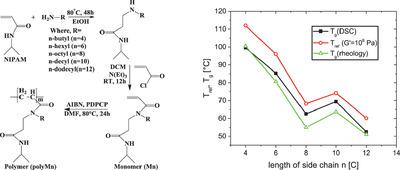当前位置:
X-MOL 学术
›
Macromol. Chem. Phys.
›
论文详情
Our official English website, www.x-mol.net, welcomes your
feedback! (Note: you will need to create a separate account there.)
Effect of n-Alkyl Side Chain Length on the Thermal and Rheological Properties of PolyN-(3-(alkylamino)-N-(3-(isopropylamino)-3-oxopropyl)acrylamide) Homopolymers
Macromolecular Chemistry and Physics ( IF 2.5 ) Pub Date : 2021-07-09 , DOI: 10.1002/macp.202100118 Archana Kumari 1 , Sambhav Vishwakarma 1 , Kheyanath Mitra 1 , Chuangbi Chen 2 , Shuming Cui 2 , Biswajit Maiti 1 , Sourov Mondal 1 , Chandra Sekhar Biswas 2 , Pralay Maiti 3 , Florian J. Stadler 2 , Biswajit Ray 1
Macromolecular Chemistry and Physics ( IF 2.5 ) Pub Date : 2021-07-09 , DOI: 10.1002/macp.202100118 Archana Kumari 1 , Sambhav Vishwakarma 1 , Kheyanath Mitra 1 , Chuangbi Chen 2 , Shuming Cui 2 , Biswajit Maiti 1 , Sourov Mondal 1 , Chandra Sekhar Biswas 2 , Pralay Maiti 3 , Florian J. Stadler 2 , Biswajit Ray 1
Affiliation

|
Four new N-isopropylacrylamide- and N-n-alkyl amine-based acrylamide monomers, N-(3-(alkylamino)-N-(3-(isopropylamino)-3-oxopropyl) acrylamide (Mn) (n = 4, 8, 10, 12) are successfully synthesized and polymerized via reversible addition-fragmentation chain-transfer polymerization (polyMn, n = 4, 8, 10, and 12), which are characterized by gel permeation chromatography, 1H NMR, Fourier transform infra red spectroscopy, thermo-gravimetry-differential thermal analysis, differential scanning calorimetry (DSC), and rheology. All polymers are thermally stable and undergo a two-step degradation process at ≈280 and ≈375 °C. Glass transition temperature (Tg)s of these polymers decrease gradually from 99.6 to 52.5 °C with increasing n-alkyl side chain length. The rheology of these polymers in melt state agrees to a typical Rouse-melt behavior and allows for confirming the Tg determined from DSC. Benzyl alcohol solution rheology proves a weak structural build-up, in particular for polyM12. Comparison of the quantum chemical calculations of polyMns with n = 4–8 reveals increase in backbone helicity with increasing n-alkyl side chain length.
中文翻译:

正烷基侧链长度对聚N-(3-(烷基氨基)-N-(3-(异丙基氨基)-3-氧代丙基)丙烯酰胺)均聚物的热学和流变学性质的影响
四种新型N-异丙基丙烯酰胺-和N - n-烷基胺基丙烯酰胺单体,N- (3-(烷基氨基) -N- (3-(异丙基氨基)-3-氧代丙基)丙烯酰胺(Mn)( n =4, 8) , 10, 12) 通过可逆加成断裂链转移聚合(polyMn,n = 4, 8, 10 和 12)成功合成和聚合,其特征在于凝胶渗透色谱,1H NMR、傅里叶变换红外光谱、热重-差热分析、差示扫描量热法 (DSC) 和流变学。所有聚合物都是热稳定的,并在 ≈280 和 ≈375 °C 下经历两步降解过程。玻璃化转变温度(Ť克)S的这些聚合物逐渐从99.6至52.5℃,增加而降低ñ -烷基侧链长度。在熔融状态下,这些聚合物的流变学同意典型劳斯熔融行为,并允许用于确认Ť克从DSC测定。苯甲醇溶液流变学证明结构较弱,尤其是聚 M12。polyMns 与n的量子化学计算的比较= 4-8 表明随着正烷基侧链长度的增加,主链螺旋度增加。
更新日期:2021-08-07
中文翻译:

正烷基侧链长度对聚N-(3-(烷基氨基)-N-(3-(异丙基氨基)-3-氧代丙基)丙烯酰胺)均聚物的热学和流变学性质的影响
四种新型N-异丙基丙烯酰胺-和N - n-烷基胺基丙烯酰胺单体,N- (3-(烷基氨基) -N- (3-(异丙基氨基)-3-氧代丙基)丙烯酰胺(Mn)( n =4, 8) , 10, 12) 通过可逆加成断裂链转移聚合(polyMn,n = 4, 8, 10 和 12)成功合成和聚合,其特征在于凝胶渗透色谱,1H NMR、傅里叶变换红外光谱、热重-差热分析、差示扫描量热法 (DSC) 和流变学。所有聚合物都是热稳定的,并在 ≈280 和 ≈375 °C 下经历两步降解过程。玻璃化转变温度(Ť克)S的这些聚合物逐渐从99.6至52.5℃,增加而降低ñ -烷基侧链长度。在熔融状态下,这些聚合物的流变学同意典型劳斯熔融行为,并允许用于确认Ť克从DSC测定。苯甲醇溶液流变学证明结构较弱,尤其是聚 M12。polyMns 与n的量子化学计算的比较= 4-8 表明随着正烷基侧链长度的增加,主链螺旋度增加。











































 京公网安备 11010802027423号
京公网安备 11010802027423号